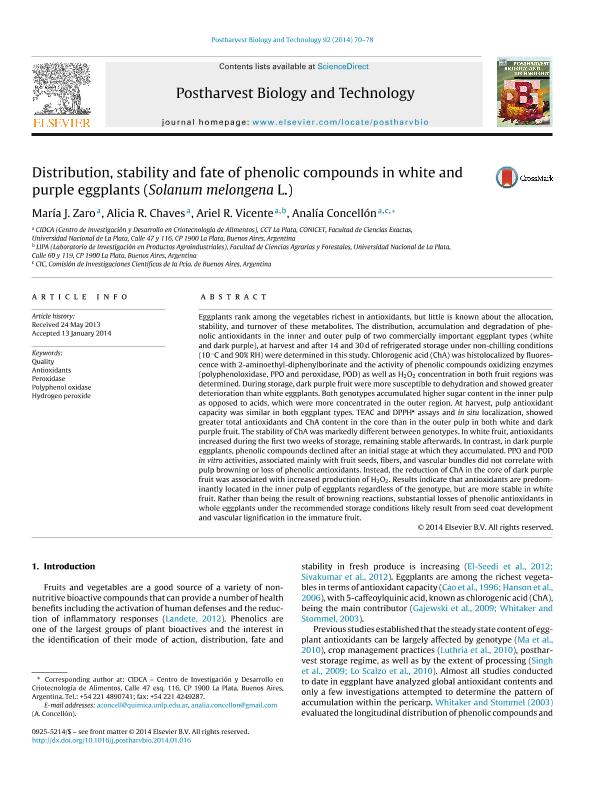Mostrar el registro sencillo del ítem
dc.contributor.author
Zaro, Maria Jose

dc.contributor.author
Chaves, Alicia Raquel

dc.contributor.author
Vicente, Ariel Roberto

dc.contributor.author
Concellón, Analía

dc.date.available
2018-01-12T18:44:23Z
dc.date.issued
2014-06
dc.identifier.citation
Zaro, Maria Jose; Chaves, Alicia Raquel; Vicente, Ariel Roberto; Concellón, Analía; Distribution, stability and fate of phenolic compounds in white and purple eggplants (Solanum melongena L.); Elsevier Science; Postharvest Biology and Technology; 92; 6-2014; 70-78
dc.identifier.issn
0925-5214
dc.identifier.uri
http://hdl.handle.net/11336/33102
dc.description.abstract
Eggplants rank among the vegetables richest in antioxidants, but little is known about the allocation, stability, and turnover of these metabolites. The distribution, accumulation and degradation of phenolic antioxidants in the inner and outer pulp of two commercially important eggplant types (white and dark purple), at harvest and after 14 and 30 d of refrigerated storage under non-chilling conditions (10 °C and 90% RH) were determined in this study. Chlorogenic acid (ChA) was histolocalized by fluorescence with 2-aminoethyl-diphenylborinate and the activity of phenolic compounds oxidizing enzymes (polyphenoloxidase, PPO and peroxidase, POD) as well as H2O2 concentration in both fruit regions was determined. During storage, dark purple fruit were more susceptible to dehydration and showed greater deterioration than white eggplants. Both genotypes accumulated higher sugar content in the inner pulp as opposed to acids, which were more concentrated in the outer region. At harvest, pulp antioxidant capacity was similar in both eggplant types. TEAC and DPPHassays and in situ localization, showed greater total antioxidants and ChA content in the core than in the outer pulp in both white and dark purple fruit. The stability of ChA was markedly different between genotypes. In white fruit, antioxidants increased during the first two weeks of storage, remaining stable afterwards. In contrast, in dark purple eggplants, phenolic compounds declined after an initial stage at which they accumulated. PPO and POD in vitro activities, associated mainly with fruit seeds, fibers, and vascular bundles did not correlate with pulp browning or loss of phenolic antioxidants. Instead, the reduction of ChA in the core of dark purple fruit was associated with increased production of H2O2. Results indicate that antioxidants are predominantly located in the inner pulp of eggplants regardless of the genotype, but are more stable in white fruit. Rather than being the result of browning reactions, substantial losses of phenolic antioxidants in whole eggplants under the recommended storage conditions likely result from seed coat development and vascular lignification in the immature fruit.
dc.format
application/pdf
dc.language.iso
eng
dc.publisher
Elsevier Science

dc.rights
info:eu-repo/semantics/openAccess
dc.rights.uri
https://creativecommons.org/licenses/by-nc-sa/2.5/ar/
dc.subject
ANTIOXIDANTS
dc.subject
HYDROGEN PEROXIDE
dc.subject
PEROXIDASE
dc.subject
POLYPHENOL OXIDASE
dc.subject
QUALITY
dc.subject.classification
Alimentos y Bebidas

dc.subject.classification
Otras Ingenierías y Tecnologías

dc.subject.classification
INGENIERÍAS Y TECNOLOGÍAS

dc.title
Distribution, stability and fate of phenolic compounds in white and purple eggplants (Solanum melongena L.)
dc.type
info:eu-repo/semantics/article
dc.type
info:ar-repo/semantics/artículo
dc.type
info:eu-repo/semantics/publishedVersion
dc.date.updated
2018-01-12T16:32:01Z
dc.journal.volume
92
dc.journal.pagination
70-78
dc.journal.pais
Países Bajos

dc.journal.ciudad
Amsterdam
dc.description.fil
Fil: Zaro, Maria Jose. Provincia de Buenos Aires. Gobernación. Comisión de Investigaciones Científicas. Centro de Investigación y Desarrollo en Criotecnología de Alimentos. Consejo Nacional de Investigaciones Científicas y Técnicas. Centro Científico Tecnológico Conicet - La Plata. Centro de Investigación y Desarrollo en Criotecnología de Alimentos. Universidad Nacional de La Plata. Facultad de Ciencias Exactas. Centro de Investigación y Desarrollo en Criotecnología de Alimentos; Argentina
dc.description.fil
Fil: Chaves, Alicia Raquel. Provincia de Buenos Aires. Gobernación. Comisión de Investigaciones Científicas. Centro de Investigación y Desarrollo en Criotecnología de Alimentos. Consejo Nacional de Investigaciones Científicas y Técnicas. Centro Científico Tecnológico Conicet - La Plata. Centro de Investigación y Desarrollo en Criotecnología de Alimentos. Universidad Nacional de La Plata. Facultad de Ciencias Exactas. Centro de Investigación y Desarrollo en Criotecnología de Alimentos; Argentina
dc.description.fil
Fil: Vicente, Ariel Roberto. Provincia de Buenos Aires. Gobernación. Comisión de Investigaciones Científicas. Centro de Investigación y Desarrollo en Criotecnología de Alimentos. Consejo Nacional de Investigaciones Científicas y Técnicas. Centro Científico Tecnológico Conicet - La Plata. Centro de Investigación y Desarrollo en Criotecnología de Alimentos. Universidad Nacional de La Plata. Facultad de Ciencias Exactas. Centro de Investigación y Desarrollo en Criotecnología de Alimentos; Argentina. Universidad Nacional de La Plata. Facultad de Ciencias Agrarias y Forestales; Argentina
dc.description.fil
Fil: Concellón, Analía. Provincia de Buenos Aires. Gobernación. Comisión de Investigaciones Científicas. Centro de Investigación y Desarrollo en Criotecnología de Alimentos. Consejo Nacional de Investigaciones Científicas y Técnicas. Centro Científico Tecnológico Conicet - La Plata. Centro de Investigación y Desarrollo en Criotecnología de Alimentos. Universidad Nacional de La Plata. Facultad de Ciencias Exactas. Centro de Investigación y Desarrollo en Criotecnología de Alimentos; Argentina. Provincia de Buenos Aires. Gobernación. Comisión de Investigaciones Científicas; Argentina
dc.journal.title
Postharvest Biology and Technology

dc.relation.alternativeid
info:eu-repo/semantics/altIdentifier/doi/http://dx.doi.org/10.1016/j.postharvbio.2014.01.016
dc.relation.alternativeid
info:eu-repo/semantics/altIdentifier/url/http://www.sciencedirect.com/science/article/pii/S0925521414000246
Archivos asociados
